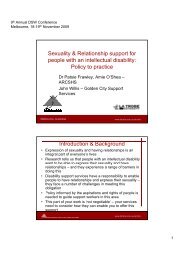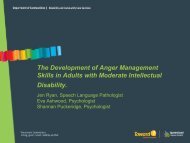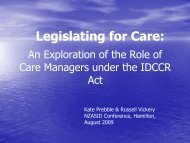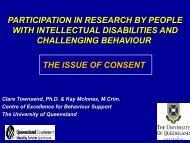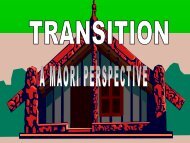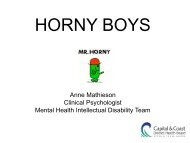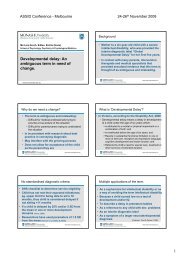The Functional Health Assessment Tool (TFHAT)
The Functional Health Assessment Tool (TFHAT)
The Functional Health Assessment Tool (TFHAT)
You also want an ePaper? Increase the reach of your titles
YUMPU automatically turns print PDFs into web optimized ePapers that Google loves.
2009 NZASID Conference Hamilton New ZealandHenrietta TripRN, MHealSc(Nursing)Intellectual Disability Community TeamSpecialist Mental <strong>Health</strong> Service, CDHBCentre for PG Nursing Studies, University of Otago,Christchurch, New Zealand
This research set out to study the extent to which<strong>The</strong> <strong>Functional</strong> <strong>Health</strong> <strong>Assessment</strong> <strong>Tool</strong>(<strong>TFHAT</strong>, Trip, 2005) contributed to the interfacebetween people with an intellectual disability & their GPwhen supported by direct-care staffTrip (2009)
Prisons of Protection (Willer, Goldberg, & Intagliata, 1980)Deinstitutionalisation challenged governing medical pathologiesof sickness & incapacity (Fergusson, 2004)<strong>The</strong>rapeutically preferable to reside in the community(Mitchell, 1864)Trip (2009)
Higher level of ill health than the general population(Knibbe & Van Hoeve, 2005)Social disadvantage impacts on physical/mental health (Emerson, 2006)Lack of co-ordinated approach in PHC contributes to poor outcomes(Kerr, 2004)A lack of awareness of health conditions more common in this population(Sowney & Barr, 2004)Staff training is insufficient (van Scronjenstein Lantman-de Valk, 2005)<strong>Health</strong> needs may be masked or exacerbated by presenting behaviour(Davis & Mohr, 2004; Lennox & Eastgate, 2004)
<strong>The</strong> Primary <strong>Health</strong> Care Strategy (MoH, 2001)<strong>The</strong> New Zealand Disability Strategy (MoH, 2001)To Have An Ordinary Life – Kia Whai Oranga Noa (MoH, 2003)~ Is intellectual disability a forgotten specialty ~(Clark, 2006)
Trip (2009)1. Non-probability purposive sampling (Polit & Beck, 2004) was usedto approach 15 direct-line managers of residential providers forpeople with intellectual disability in the Canterbury region of NewZealand1. A Pre-Implementation Questionnaire was completed by directcarestaff and the GP of a person with intellectual disabilitywith whom they work & were going to complete <strong>The</strong> <strong>Functional</strong><strong>Health</strong> <strong>Assessment</strong> <strong>Tool</strong> with (<strong>TFHAT</strong>, Trip, 2005)
1. An education session was held for the responding group ofdirect-care staff regarding the implementation of <strong>TFHAT</strong>2. Direct-care staff then completed <strong>TFHAT</strong> with client &forwarded a copy to the GP3. Incidental GP appointment was anticipated. Follow up with therespective direct-line managers established the likelihood of thisoccurring prior to Phase 3Trip (2009)
1. Post-Implementation Questionnaire was distributedfor the direct-care staff & GPs who were part of Phase12. Semi-structured interviews were to be conductedwith people who have an intellectual disability & whowere part of <strong>TFHAT</strong> Implementation (Phase 2)
RESPONDENTS STAFF GPS TOTALSent 15 11 26Returned 12 5 17Response Rate 80% 45.5% 65.4%
Support required to access GPDifficulties experienced by people with intellectual disability inhaving their health needs met by GPInvolvement of the individual during GP appointmentFactors which could improve the interface between people withintellectual disability & their GPInformation available to GP regarding functional & cognitiveabilities of individualTraining on the health needs of people with intellectual disability
Difficult to have health needs met : GP 80% Staff 58.3%Some conditions more prevalent : GP 100% Staff 50%Able to express health concerns : GP 0% Staff 25%Difficult recognise health changes : GP 60% Staff 50%Staff have good knowledge of ind. : GP 60% Staff 83%Overview of function would assist : GP 80% Staff 100%<strong>Health</strong> record to improve interface : GP 80% Staff 100%<strong>The</strong>re is sufficient time for appt. : GP 40% Staff 25%Behav. impacts on health support : GP 80% Staff 58.3%GP is skilled to meet health needs : GP 40% Staff 33.3%Staff facilitate communication : GP 100% Staff 91.7%GP consults directly with PWID : GP 20% Staff 8.3%Have sufficient education/training : GP 20% Staff 50%Need for more education/training : GP 60% Staff 75%
RESPONDENTS STAFF GPs TOTALSent 12 8 20Returned 6 1 7Response Rate 50% 12.5% 35%
Male (2) NZ Maori (1)Female (4) NZ European (5)20-30 yrs (2) 31-40yrs (2)41-50yrs (1) 51-60yrs (1)Mild ID (2) Autism (1) MH (1)Mod ID (4) Cerebral Palsy (1)Contact Frequency with GP Monthly (1) 3Monthly (3)
<strong>Health</strong> information identified through implementing <strong>TFHAT</strong>Advantages of implementing <strong>TFHAT</strong>Disadvantages of implementing <strong>TFHAT</strong>Usefulness to the interface between people with ID & GPsRecommendations for using <strong>TFHAT</strong> in the futureEducation/training requirements to improve health outcomesfor people with an intellectual disability
Only Sam had choice to decide when to see GPGP speaks to Sam & Leslie directly, but not always to Jo whowould like this to happen more oftenStaff talk with Sam & Leslie about appointment - Not so for JoSometimes the GP listens to Jo who reported not having theopportunity to ask questions
Leslie & Jo reported that they often felt hurriedJo usually shares the appointment with flatmatesStaff noted that Jo’s GP could be more thoroughSam & Leslie thought the information that staff wrote in<strong>TFHAT</strong> was useful as did their GPSam identified a goal of trying to “get a little moreindependent”
Utility of <strong>TFHAT</strong> (Trip, 2005):- Future health screening measures can be put in place- Historical, social, family medical & health history is of value- Knowing how a person usually presents & functions wouldassist in recognising changing health needs in people with ID- Up to date health records would improve the healthinterface between people with intellectual disability & GPs
Recruitment methodRole of research participantsComplexity of the research processNarrow the scope of the research aim/angleApplication for other cultural/social settingsClients transferring between GPs during the researchTimeframe required for collation of <strong>TFHAT</strong>
Normalisation:- Barriers identified do not exemplify social norms- Roles captured in this research are suggestive of continued stigmafor this populationSocial Role Valorisation:- Client : Spectator / Recipient- Staff : Taxi Driver / Interpreter / Facilitator- GPs : Revered / “<strong>The</strong> Qualified One” / Powerful
Union of the Physically Impaired Against Segregation (1976)Fundamental Principles of Disability distinguished betweenphysical disability (impairment) and disability as a sociallyconstructed phenomenon (Richardson, 2001)Seeks to identify, adjust / remove barriers which prevent orlimit health care access for people with intellectual disability(Mansell & Northway, 2003)
Implement the principles identified in To Have an Ordinary Life– Kia Whai Oranga Noa (National Advisory Committee on health& Disability, 2003)Target health education for health professionals includingmedical, allied & disability service providers.Liaison is required between PHC & intellectual disability serviceproviders. <strong>The</strong> same standards of service provision should beenvisioned for those residing in the wider communityindependently or with family/whanau/caregivers
Arranging appointmentsInclusion of the individual in decisions pertaining to their ownhealthcare to the extent possibleSubsidy for longer (individual) appointments and/or for annualcomprehensive health review to enable comparisons againstbaseline documentation
henrisplace@actrix.co.nz



